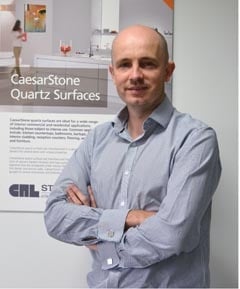Chris Pepper, Marketing & Business Development Manager for CR Laurence, the UK home of Caesarstone, highlights the latest trends in quartz surfaces.
- What are the latest trends in laminates, solid surfaces and natural stone?
For solid surfaces, it’s the natural, organic colours that are trending. Those zingy, sometimes downright blingy surfaces from a few years back, have given way to compositions that manage to replicate the beauty of natural materials such as stone and marble with astonishing accuracy.
As such, the modern colour palette is all about timeless neutrals – think earthy, creamy or putty colours – that work across a wide range of different cabinetry and that, most importantly, will look good for a long time.
- What are the latest trends in patterns, colours, texture and perceived texture?
Again, it’s all about a natural, organic aesthetic that even verges on the rustic. Surfaces can account for a lot of space in a kitchen/dining area and people don’t want hard, cold materials that lack texture – or perceived texture. There is a definite move towards surfaces that can create a warmer, more tactile effect. Marble is not always the best choice for kitchen applications – yet those surfaces that can recreate the tactility, depth and, often, the slightly ‘imperfect’ appeal that marble offers, have been gaining in popularity for some time now.
- What about thickness – in your experience, do consumers prefer thick or thin?
The 20mm thickness seems to be very popular; probably because it can also be built up to create a choice of affordable profiles. But, of course, surface thickness is often driven by budget, so I think it’s often down to the customer’s pocket, rather than their preference.
- What about edge profile, feature edging etc?
Profiles remain one of the best ways to really add something special to a run of surface. Slim profiles such as a half bullnose or slim bevel work well with greater expanses of surfaces, while a statement profile such as New York or Ogee will set off an island beautifully.
- Are consumers sticking to a single worktop material or are they mixing them for visual contrast and practical benefits?
The ‘mix and match’ approach to surfaces resulted from consumers loving the appearance of certain worktops that weren’t necessarily the best choice for certain areas – for example, marble, which is porous and can stain easily, or wood in a wet area. Latterly however, this concept is becoming outdated – advanced design and manufacturing techniques of quartz and composites in particular have meant that consumers can ‘have it all’. It is entirely possible for them to buy a surface that wholly replicates the beauty of, say, marble yet that is hardworking, resistant to stains, scratching and waterproof.
- Are environmental concerns influencing consumer buying decisions?
Just about everyone is now more tuned into buying in an environmentally responsible manner. For completely natural materials such as stone, slate, granite and wood, it’s absolutely key – but consumers buying quartz surfaces are also keen to know they are buying worktops that have been formulated and manufactured responsibly.
Caesarstone has long exercised an environmentally-aware approach – and the company was actually the first quartz manufacturer to achieve ISO 14001, the international standard for environmental preservation. In addition, our surfaces comply with the American Global Environmental Institute’s rigorous Greenguard standards. These ensure the surfaces are safe for the environment and that they do not release any harmful substances into the environment.
- Caesarstone’s Visualiser tool helps users to see how different ranges, colours and finishes work together in a real domestic environment. It can be used online at www.caesarstone.co.uk or downloaded as an app.

